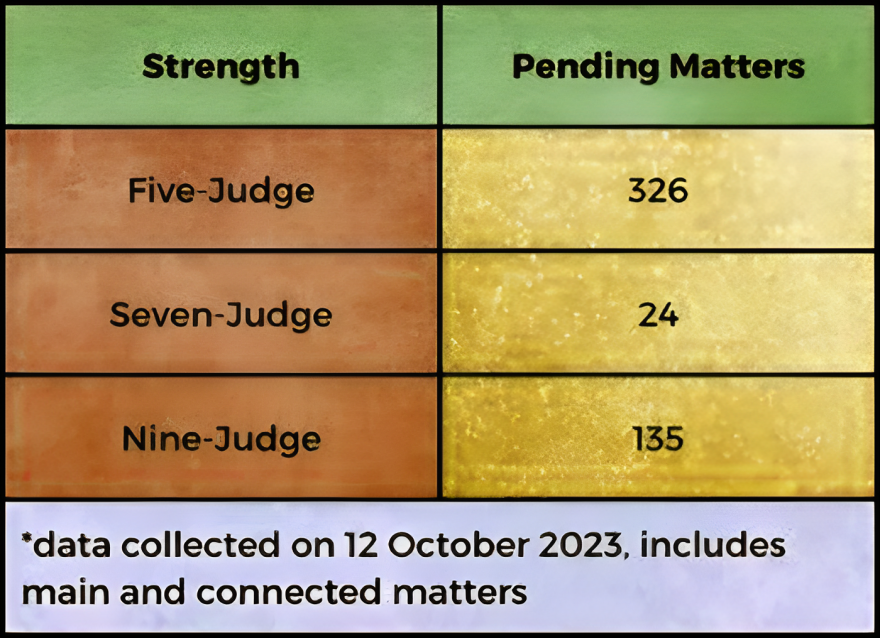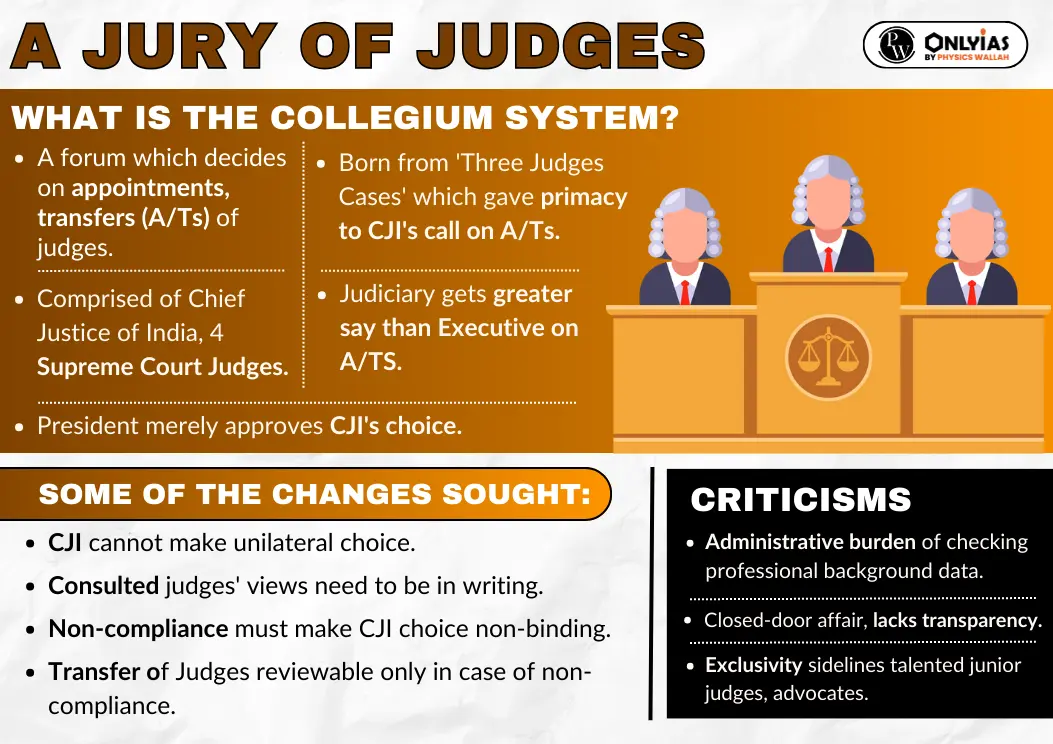Context: This article is based on the news “It’s time to revamp the structure of the Supreme Court of India” Which was published in the Hindu. Recently, in response to the rising pendency of cases in the Supreme Court, the Chief Justice of India (CJI) announced his intent to create constitutional benches of varied strengths as a permanent feature of the Court.
Rising Pendency of Cases in the Supreme Court of India- A Call for Structural Reform
- Currently, the Supreme Court of India faces a high pendency of cases (79,813 cases), raising demand for a structural change.
- The Constitution Bench (V. Vasanthakumar vs. H.C. Bhatia) is analyzing these issues and considering measures to protect citizen’s basic right to access the Supreme Court.

Also Read: High Pendency at the Supreme Court of India
Historical Background of the Supreme Court of India
- During the Colonial Era, There were three Supreme Courts- in Bombay, Calcutta, and Madras.
- The Indian High Courts Act of 1861: replaced the Supreme Courts with High Courts for separate regions.
- The Government of India Act, 1935: It created the Federal Court of India as an appellate body for the Privy Council and High Courts.
- Indian Constitution: The present Supreme Court was founded on January 28, 1950, under Article 124 of the Constitution.
- It came into being in Delhi as a result of Article 130.
- Composition: 34 judges, including the Chief Justice, The first Supreme Court included eight judges, including the CJI. With time and need, Parliament increased the number of judges from eight in 1950 to 11 in 1956, 14 in 1960, 18 in 1978, 26 in 1986, 31 in 2009 and 34 in 2019.
What are the features of the Supreme Court of India?
- Constitutional Court: The Supreme Court of India serves as a Constitutional Court and Court of Appeal.
- Guardian of Fundamental Rights: the Court serves to protect citizens from the excesses of the legislature and executive.
- Benches: The Court sits on varying-sized benches, as determined by the CJI (the Master of the Roster).
- Constitution Benches: Provision is provided in Article 145(3) of the Constitution.
- Composition: It typically comprises five (minimum), seven, or nine judges, deliberating on a substantial question of law as to the interpretation of the Constitution.
- Types of Jurisdiction: It has three jurisdictions under the Constitution- original, appellate, and advisory.
- Hearing of Cases: These are heard by Division Benches (of two judges) or full Benches (three judges) to examine a wide range of topics, such as film prohibitions/restrictions.
- Broad Jurisdiction: It includes public interest litigations, such as secularism being removed from the Constitution’s Preamble.
- Advisory jurisdiction: Article 143: For hearing any reference that deals with the power of the President to consult the Court.
Why is there a need for restructuring the Supreme Court of India?
- High Pendency of Cases – Across all courts in the country, more than 4 crore cases are currently pending, with around 70,000 cases just before the Supreme Court of India.
- Many sensitive cases such as challenges to the reading down of Article 370 of the constitution, the Citizenship (Amendment) Act, and Electoral bonds remained pending for several years (see image).
- Special Leave petition: The court has interpreted its SLP jurisdiction very widely, saying that it can interfere even with findings of fact. there is no clear benchmark for determining which cases deserve admission under the SLP route.
- Geographical Inaccessibility: The Parliamentary Standing Committee observed that the Delhi-centric Supreme Court creates a significant hurdle for litigants from faraway areas of the country and denies them the fundamental right to access justice.
- Collegium system: The system of judges appointing judges has been criticized for lack of transparency and accountability.

-
- The National Judicial Appointments Commission (NJAC) Act was struck down by the Supreme Court of India in 2015, and Parliament has yet to enact new legislation.
- Diversity Deficit: The representation of Scheduled Castes, Scheduled Tribes, Other Backward Classes, Women, and Minorities is far below the desired levels and does not reflect the social diversity of India.
- For instance, since 2018, the percentage of High Court judges appointed from Scheduled Castes and Scheduled Tribes was 3% and 1.5%, respectively.
- Short Tenures and Early Retirement: As per Articles 124(2) and 217(1), judges of the Supreme Court and High Courts, at present, hold their office until they attain the age of 65 and 62 years, respectively.
- The average tenure of a Supreme Court judge is 5 years. This is a relatively short tenure compared to other countries, such as the United States, where the average tenure is 22 years.
- Master of Roster: Critics say that the system of Master of the Roster has turned into a system of Roster of the Master. The Chief Justice of India has the power to assign cases to different benches of the Supreme Court of India.
- This power has been criticized for giving the Chief Justice too much control over the Supreme Court.
- Colonial Practices: Vacations in the Supreme Court and High Courts, the law of criminal contempt, English as the court language, etc
- The entire court on vacation at once leads to the higher judiciary shutting down for a couple of months per year. This results in the pendency of cases and the inconvenience faced by litigants.
- Article 130 of the Constitution states that the Supreme Court of India will sit in Delhi or in such other places as the Chief Justice of India, with the approval of the President, may appoint.
- Article 136 of the Constitution of India vests the Supreme Court of India with a special power to grant special leave to appeal against any judgment or order or decree in any matter or cause passed or made by any Court/tribunal in the territory of India.
|
Also Read: Judges’ Appointment in India: A Balancing Act Between Centre and Collegium
The Way Forward:
Separate Constitution Bench: the work of the Supreme Court of India could be split so that there is a Final Court of Appeal and a permanent Constitution Bench to ensure greater judicial stability and consistency.
- Tenth Law Commission of India (1984): It proposed splitting the Supreme Court of India into the Constitutional and Legal divisions.
- Eleventh Law Commission (1988): It states that dividing the Supreme Court into parts would make justice more widely available.
- The Supreme Court (1986): In Bihar Legal Support Society vs. Chief Justice of India (1986), the Supreme Court wanted to establish a National Court of Appeal. This would allow the Supreme Court only to entertain constitutional and public law-related questions.
- ➢ It could help the Supreme Court to deal with constitutional issues and other cases of national importance on a day-to-day basis.
Regional benches of SC: In 2009, the 229th Law Commission report recommended that four regional benches of the Supreme Court of India be set up, rather than a separate Court of Appeal, which can deal with appeals from their regions, while the constitution bench would sit in Delhi.
Use of Digital Technology: Technology is the “best tool” courts could wield against the inefficiency and opacity in judicial processes and to overcome the procedural barriers to justice.
- Access to video conferencing facilities or hearing through the hybrid mode would enable access to justice and improve the case management and court management system.
Gender and Social diversity: Making it mandatory to include one woman, one Scheduled Caste, and one Scheduled Tribe member in the collegium to recommend judges to the higher judiciary would help to ensure gender and social diversity.
Increasing Retirement Age: Justice Venkatachalaiah Report(2002) recommended raising the retirement age of High Court and Supreme Court judges to 65 and 68, respectively.
- Raising the retirement will leave the judges less incentive to pander to the government as they are less likely to need post-retirement jobs.
- Additionally, the Supreme Court Collegium may devise a system of appraisal to evaluate judges’ performance and health conditions before extending their tenure.
- Under Article III of the US Constitution, Supreme and Subordinate court judges hold their offices for life where as Australia and Ireland have 70 as the prescribed retirement age. At the same time, the upper limit is 75 years in Canada.
- The UK ordinarily provides for a retirement age of 70 for judges (although the services of certain individual judges can be extended till they are 75).
Also Read: Law Commission Of India
Conclusion
Addressing the high pendency of cases in the Supreme Court of India necessitates comprehensive structural reforms, encompassing the establishment of specialized benches, regional decentralization, technological integration, and measures to enhance diversity and judicial tenure.
| Prelims Question (2014)
The power of the Supreme Court of India to decide disputes between the Centre and the States falls under its
(a) Advisory jurisdiction
(b) Appellate jurisdiction
(c) Original jurisdiction
(d) Writ jurisdiction
Ans: (c)
|
![]() 30 Nov 2023
30 Nov 2023



